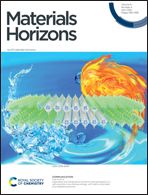A multifunctional Fenton nanoagent for microenvironment-selective anti-biofilm and anti-inflammatory therapy†
Abstract
Bacterial biofilm infections are intractable to traditional antibiotic treatment and usually cause persistent inflammation. Chemodynamic therapy (CDT) based on the Fenton reaction has recently emerged as a promising anti-biofilm strategy. However, the therapeutic efficacy of current Fenton agents often suffers from inefficient Fenton activity and lacks anti-inflammatory capability. Herein, FePS3 nanosheets (NSs) are explored for the first time as novel microenvironment-selective therapeutic nanoagents for bacterial biofilm infections with both self-enhanced Fenton activity for an anti-biofilm effect and reactive oxygen species (ROS) scavenging properties for an anti-inflammatory effect. In biofilms with acidic microenvironments, FePS3 NSs release Fe2+ to generate toxic ROS by Fenton reaction and reductive [P2S6]4− to enhance the Fenton activity by reducing Fe3+ to Fe2+. In the surrounding normal tissues with neutral pH, FePS3 NSs scavenge ROS by reductive [P2S6]4− with an anti-inflammatory effect. This work demonstrates multifunctional Fenton nanoagents with microenvironment-selective ROS generation and elimination properties for effective treatment of bacterial biofilm infections with both anti-biofilm and anti-inflammatory effects.

- This article is part of the themed collection: Horizons Community Board Collection: Antimicrobial materials and surfaces


 Please wait while we load your content...
Please wait while we load your content...